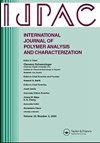Synthesis, rheological and thermal studies of Gum ghatti-cl-poly(acrylic acid) hydrogels containing CoFe2O4 nanoparticles
IF 1.7
4区 工程技术
Q4 POLYMER SCIENCE
International Journal of Polymer Analysis and Characterization
Pub Date : 2024-10-24
DOI:10.1080/1023666X.2024.2410746
引用次数: 0
Abstract
In this work, Gum ghatti-cl-poly(acrylic acid)/CoFe2O4 (GGAACF) hydrogels were synthesized using a free radical polymerization technique, with CoFe2O4 nanoparticles incorporated via a co-precipitation method using nitrates as precursors. Thermal gravimetric analysis (TGA) revealed that the inclusion of CoFe2O4 nanoparticles enhanced the thermal stability of the hydrogels. Swelling studies indicated that the addition of 30 mg of CoFe2O4 nanoparticles maximized water retention. Rheological assessments demonstrated non-Newtonian behavior, with flow curves fitted best by the Power Law model. The incorporation of CoFe2O4 nanoparticles significantly improved the hydrogel’s elasticity and viscosity, as evidenced by a higher storage modulus (G′) compared to the loss modulus (G″) across all frequencies, indicating the elastic nature of the hydrogels. The decrease in complex viscosity with increasing frequency confirmed the pseudoplastic properties of the hydrogels, attributed to the random alignment of CoFe2O4 nanoparticles within the matrix. Tan δ values were below unity at all tested frequencies, underscoring the hydrogels’ strong elastic properties. These findings highlight the effectiveness of rheological analysis in characterizing the viscoelastic behavior of polymer hydrogels, which can be tailored for various applications.
含 CoFe2O4 纳米颗粒的 Gum ghatti-cl-poly(acrylic acid) 水凝胶的合成、流变学和热学研究
本研究采用自由基聚合技术合成了 Ghatti-cl-poly(acrylic acid)/CoFe2O4 水凝胶(GGAACF),并以硝酸盐为前驱体,通过共沉淀法加入了 CoFe2O4 纳米粒子。热重分析(TGA)显示,CoFe2O4 纳米粒子的加入增强了水凝胶的热稳定性。膨胀研究表明,添加 30 毫克 CoFe2O4 纳米粒子可最大限度地保持水分。流变学评估显示了非牛顿流体行为,流动曲线与幂律模型的拟合效果最佳。掺入 CoFe2O4 纳米粒子后,水凝胶的弹性和粘度明显提高,这表现在所有频率下的储存模量(G′)都高于损失模量(G″),表明水凝胶具有弹性。复合粘度随频率增加而降低,证实了水凝胶的假塑性特性,这归因于 CoFe2O4 纳米粒子在基质中的随机排列。在所有测试频率下,Tan δ 值都低于统一值,突出了水凝胶的强弹性特性。这些发现凸显了流变分析在表征聚合物水凝胶粘弹性行为方面的有效性,聚合物水凝胶可为各种应用量身定制。
本文章由计算机程序翻译,如有差异,请以英文原文为准。
求助全文
约1分钟内获得全文
求助全文
来源期刊
CiteScore
3.50
自引率
5.30%
发文量
37
审稿时长
1.6 months
期刊介绍:
The scope of the journal is to publish original contributions and reviews on studies, methodologies, instrumentation, and applications involving the analysis and characterization of polymers and polymeric-based materials, including synthetic polymers, blends, composites, fibers, coatings, supramolecular structures, polysaccharides, and biopolymers. The Journal will accept papers and review articles on the following topics and research areas involving fundamental and applied studies of polymer analysis and characterization:
Characterization and analysis of new and existing polymers and polymeric-based materials.
Design and evaluation of analytical instrumentation and physical testing equipment.
Determination of molecular weight, size, conformation, branching, cross-linking, chemical structure, and sequence distribution.
Using separation, spectroscopic, and scattering techniques.
Surface characterization of polymeric materials.
Measurement of solution and bulk properties and behavior of polymers.
Studies involving structure-property-processing relationships, and polymer aging.
Analysis of oligomeric materials.
Analysis of polymer additives and decomposition products.

 求助内容:
求助内容: 应助结果提醒方式:
应助结果提醒方式:


